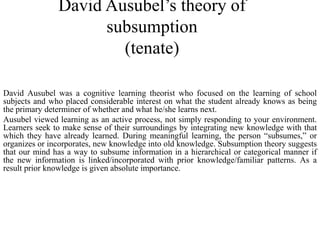David ausubelu2019s theory of subsumption
•
1 gostou•662 visualizações
Denunciar
Compartilhar
Denunciar
Compartilhar
Baixar para ler offline

Mais conteúdo relacionado
Mais procurados
Mais procurados (20)
Semelhante a David ausubelu2019s theory of subsumption
Semelhante a David ausubelu2019s theory of subsumption (20)
Lesson 6 ppt- Relabeth David-Rovelyn Flores- Yvonne Rebecca Pastorfide

Lesson 6 ppt- Relabeth David-Rovelyn Flores- Yvonne Rebecca Pastorfide
AUSUBEL'S MEANINGFUL VERBAL LEARNING/SUBSUMPTION THEORY

AUSUBEL'S MEANINGFUL VERBAL LEARNING/SUBSUMPTION THEORY
Último
Introduction to Research ,Need for research, Need for design of Experiments, ...

Introduction to Research ,Need for research, Need for design of Experiments, ...Nigar Kadar Mujawar,Womens College of Pharmacy,Peth Vadgaon,Kolhapur,416112
Mattingly "AI & Prompt Design: Large Language Models"

Mattingly "AI & Prompt Design: Large Language Models"National Information Standards Organization (NISO)
Mattingly "AI & Prompt Design" - Introduction to Machine Learning"

Mattingly "AI & Prompt Design" - Introduction to Machine Learning"National Information Standards Organization (NISO)
Último (20)
Satirical Depths - A Study of Gabriel Okara's Poem - 'You Laughed and Laughed...

Satirical Depths - A Study of Gabriel Okara's Poem - 'You Laughed and Laughed...
Introduction to Research ,Need for research, Need for design of Experiments, ...

Introduction to Research ,Need for research, Need for design of Experiments, ...
Employablity presentation and Future Career Plan.pptx

Employablity presentation and Future Career Plan.pptx
Q-Factor HISPOL Quiz-6th April 2024, Quiz Club NITW

Q-Factor HISPOL Quiz-6th April 2024, Quiz Club NITW
INCLUSIVE EDUCATION PRACTICES FOR TEACHERS AND TRAINERS.pptx

INCLUSIVE EDUCATION PRACTICES FOR TEACHERS AND TRAINERS.pptx
Mattingly "AI & Prompt Design: Large Language Models"

Mattingly "AI & Prompt Design: Large Language Models"
BIOCHEMISTRY-CARBOHYDRATE METABOLISM CHAPTER 2.pptx

BIOCHEMISTRY-CARBOHYDRATE METABOLISM CHAPTER 2.pptx
Q-Factor General Quiz-7th April 2024, Quiz Club NITW

Q-Factor General Quiz-7th April 2024, Quiz Club NITW
Oppenheimer Film Discussion for Philosophy and Film

Oppenheimer Film Discussion for Philosophy and Film
Mattingly "AI & Prompt Design" - Introduction to Machine Learning"

Mattingly "AI & Prompt Design" - Introduction to Machine Learning"
David ausubelu2019s theory of subsumption
- 1. David Ausubel’s theory of subsumption (tenate) David Ausubel was a cognitive learning theorist who focused on the learning of school subjects and who placed considerable interest on what the student already knows as being the primary determiner of whether and what he/she learns next. Ausubel viewed learning as an active process, not simply responding to your environment. Learners seek to make sense of their surroundings by integrating new knowledge with that which they have already learned. During meaningful learning, the person “subsumes,” or organizes or incorporates, new knowledge into old knowledge. Subsumption theory suggests that our mind has a way to subsume information in a hierarchical or categorical manner if the new information is linked/incorporated with prior knowledge/familiar patterns. As a result prior knowledge is given absolute importance.
- 2. • Teachers are encouraged to teach prior knowledge first rather than new information to help information subsume. Advance organizers provide concepts and principles to the students directly in an organized format. The strategy of “advance organizers” basically means to classify/ categorize/ arrange (organize) information as you proceed (advance) to the next complex level. One can assume that the role of the teacher and instructional designer is to consider these variables by investigating and providing the appropriate subsumers to facilitate meaningful verbal learning. Learning occurs in a subsumption process whereby the learner progresses through three stages: (1) preliminary operations, (2) obliterative stage, and (3) learning stage.
- 3. • He • defines learning as “… a change in the availability or • future reproducibility of the learn • ing material” ( • Ausubel, 1962, p. 218) and assumes thatcognitive structure (i.e., knowledge • ) is “hierarchically organized in terms of highly inclusive • concepts under which are subsumed less inclusive sub • concepts and informational data”